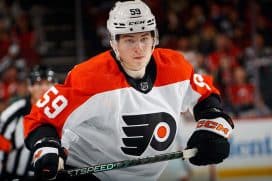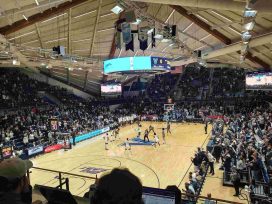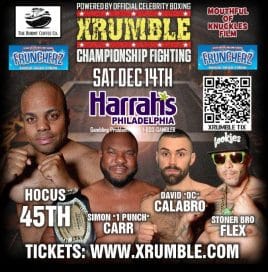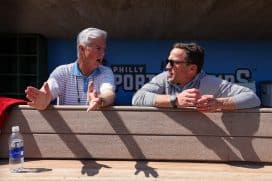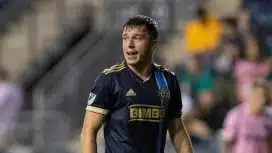Phillies
A Closer Look At The Phillies Non-Roster Invitees For 2023 Spring Training

On a Tuesday in January, the Phillies officially announced their non-roster invitees.
With most eyes on the NFL Playoffs and the Eagles Super Bowl bound, many fans likely didn’t pay much attention to the list at the time of the announcement. With the NFL now in offseason, it’s time for many of those same Philadelphia sports fans to look toward the Phillies and Spring Training again.
While many fans may know some of the names on the list, most will likely not know all 21. With that in mind, it may be worthwhile to take a deeper look at who each of these players are.
Mick Abel (RHP)
Many fans have likely heard of Abel at this point. The Phillies first-round pick (15th overall) in 2020, Abel was selected out of his Oregon high school and immediately began making prospect lists. Of course, there was no minor league season in 2020, so Abel’s minor league debut came in 2021. He played that full season in Low-A Clearwater and started his 2022 campaign in Lakewood before ending the year at AA Reading. While he didn’t have all too many innings in Reading, he has actually improved at each level so far, taking his 4.43 ERA in Clearwater down to a 3.52 in the Eastern league.
Home runs have been the largest concern for the flamethrower, but when you throw 100mph that isn’t all that uncommon. Abel is currently listed as the Phillies No. 2 prospect and is the No. 9 RHP prospect in all of MiLB. Overall, he is the No. 48 prospect in the minors. He certainly has a chance to make the opening day roster, but of the Phillies top three pitching prospects, Abel may be the one who would benefit most from additional time in the minors.
Mark Appel (RHP)
Appel is a player that all fans should really be rooting for this Spring. Once a major piece of the trade that sent Ken Giles to Houston and brought the Phillies other players like Vince Velasquez and Tom Eshelman, Appel had a bit of a stigma attached to him. Once the first overall pick in the draft, Appel reached AA with the Astros and continued to struggle. His ERA never got below 4.26 and he was simply not missing bats with opposing batters hitting better than .250 against him at each turn. The hope was that a change of scenery could help him out, but that did not come to fruition as he continued to struggle (with both shoulder injuries and his pitching) in the Phillies franchise. Ultimately, he chose to retire and he became just the third player to be the first overall pick and not make it to the majors (excluding active MiLB players).
For three years following that, Appel’s name could still be found on the Lehigh Valley IronPigs roster under the restricted list. Perhaps the Phillies knew something that others and even Appel himself did not, but Appel chose to return to baseball in 2021 after finally getting healthy, both physically and mentally. He began to talk more about his journey and took up an attitude of having fun rather than trying to be the top prospect. He struggled, as could be expected of someone who hadn’t thrown in several years, but ultimately decided he wanted to stay in baseball. A switch to the bullpen in 2022 saw him post a strong performance in AAA, where he recorded a 3.15 ERA across 40 innings – the best he had ever performed at any Minor League level.
On June 29 of last season, Appel removed his name from the list of first overall picks not to make the Majors with his appearance against the Braves for a Phillies team that was down several bullpen arms. He appeared in just six games at the Major League level, but he pitched 10 and a third innings and allowed just two runs with five strikeouts. Appel was a free agent this season, but chose to re-sign with the Phillies. He will certainly have a positive affect on the clubhouse and the young pitchers around him, but he may have a real shot of taking a spot in the bullpen if he can continue to build on his performance as a relief pitcher, a role he’s been in for just one season at the two highest levels of play MLB/MiLB have to offer.
Andrew Baker (RHP)
In reality, Baker is not likely to make the team out of the gate in 2023, but the Phillies are certainly intrigued by him and would like to see how he does against some top competition. Baker was an 11th-round pick in the 2021 draft out of a college in Florida (Chipola JC), so has simply not had many opportunities in the minors yet. With 2022 being his first season, he has thrown just over 66 innings in his career. Baker has spent all of that time as a reliever, learning to utilize his 100+mph fastball by using more power over a shorter period of time.
Baker earned a late call up to AA Reading in 2022 and had some impressive performances there. In 10 and two thirds innings, Baker allowed just one run and three hits. He also struck out 11. He will need to work on his control, however, as he did allow five batters a free pass during that time.
Baker was listed as the Phillies’ 28th overall top prospect by MLB at the end of the 2022 season.
Ben Bowden (LHP)
One of the players on the list who has not spent time in the Phillies minor league system already, Bowden was with the Rockies system for most oh his career before spending time at three separate AAA teams in 2022 as he was claimed by the Rays and then traded to the Giants over the course of the season. In AAA, he threw 57.2 innings with an ERA of 5.46.
Bowden did find himself in the Major Leagues (with Colorado) for most of the 2021 season, but he posted a not-so-great 6.56 ERA across 35.2 innings. He was in the 85th percentile for his fastball spin rate that season, which may be why the Phillies want to see him in camp, but his other peripherals were not great.
Jon Duplantier (RHP)
Duplantier could be looked at as a player similar to Bowden, though he had experienced success earlier in his career. In 2021, Duplantier was technically with three teams (Diamondbacks, Giants, Dodgers), though most of those transactions took place in the offseason. He saw the majors with Arizona in 2021, but posted a brutal 13.15 ERA in only 13 innings. His AAA stats this season amount to just eight innings as injuries kept him out the rest of the year.
Prior to missing an entire season due to COVID in 2020 and then having just 21 inning between injuries the following season, Duplantier had posted a respectable 4.42 ERA (3.95 FIP) across 36.2 innings at the major league level for the Diamondbacks. He was used more in long relief and actually only allowed runs one time when he pitched fewer than two innings. His ERA would have been 3.75 without that implosion.
Vito Friscia (C)
Friscia is from New York, but has suited up for team Italy multiple times now, including a stint around the All-Star break last season. Entering his fourth season in the Phillies minor league system, Friscia is now the Phillies top catcher not on the 40-man roster following the trades of both Logan O’Hoppe and Donny Sands. He would figure to play in AAA with Rafael Marchan this season unless they’d prefer to see him as the everyday starter in AA with Marchan starting each game in AAA.
While Friscia carried a .265/.378/.416 slash line in Jersey Shore, he did see his offensive numbers dip just a bit (.245/.374/.415). Friscia has no speed, but does have some power with 10 homeruns and 16 doubles (plus a triple) in 2022. Defensively, he’s a good game caller and has the ability to throw out runners (three caught in 24 games). It should be noted that Friscia did spend quite a bit of time in the outfield or as the DH for a AA team that wanted Logan O’Hoppe behind the plate every day for over half the year and in a system that lacked many outfield options early on due to injuries at the major league and AAA level.
Friscia is a positive guy who would certainly earn himself the moniker of being a “baseball guy”, so his presence in camp will likely be felt even though there’s little to no chance he ultimately winds up in Philadelphia this season.
Jim Haley (UTL)
2022 will be Haley’s first professional season which he did not spend entirely with the Rays organization. The Lansdowne native went to Penn State and has serves as a utility man throughout his minor league career. He seemingly had a breakout season in 2019, earning a berth to what was then the High-A All-Star game and continuing that level of play in AA. That season, he put up 16 home runs and 27 stolen bases to go with a .282/.329/.443 slash line all while constantly moving around the diamond and throughout the batting order.
Like many players, Haley’s career was disrupted by the pandemic and the lack of minor league play in 2020. When the minors returned in 2021, Haley struggled to the tune of a .203/.273/.388 slash line. He appeared in 30 fewer games, saw his walks and steals fall and his strikeouts actually increase despite having nearly 25% fewer at bats. Those struggles continued into 2022 (despite some minor improvements) when the Rays promoted him to AAA and gave him more playing time. He did, however, end the season with a slash line of .333/.412/.400 in his last nine games.
Haley has never reached the majors and may only be a player that the Phillies hope can provide some veteran leadership and organizational depth, but if they can work with him to cut down on his strikeout rate and get a bit more contact there’s a chance he can get back to that 2019 form and become a valuable utility man, something the Phillies have found themselves in need of in many of the past several years.
Louis Head (RHP)
The Guardians, Dodgers, Mariners, Rays, Marlins and Orioles organizations have all employed Head at one point or another. He does not have particularly overpowering stuff, but has had some success. In 2021, Head reached AAA and put up a stellar 2.20 ERA in 28.2 innings of work. Opposing batters hit for an average of just .194 against him. He maintained similar numbers when the Rays called him up, when he threw 35 innings to the tune of a 2.31 ERA and had 32 strikeouts to only nine walks.
The following offseason, he was traded to the Marlins and started out where he left off. He threw his first 15 games and allowed only two runs in 16 innings with 15 strikeouts and seven walks. That’s good for a 1.13 ERA and a 2.74 FIP. Then came June. In just eight games in June, Head imploded five times. During that strech, he had a 19.96 ERA with just an eight to four strikeout to walk ratio. He was placed on the injured list with a shoulder impingement.
When Head was healthy again in August, the Orioles claimed him. He pitched five more innings in five games for them and allowed just one run, though his strikeout to walk rate was still a concern at that time. If you exclude that disastrous June when he was dealing with an injury, that leaves Head with a 1.29 ERA on the season and a 1.93 career ERA over 56 inning in the major leagues. Despite not having overpowering stuff, Head should have a real shot to at least put himself in a position to be one of the first guys called upon when an injury occurs – as long as that injury is behind him and he can throw as he did the two seasons before.
John Hicks (C)
Hicks is basically the team’s obligatory veteran catcher. With the loss of two prospects at the position due to trades, the organization is thin at the higher levels and Hicks will figure to be someone they look to keep around for veteran leadership and to assist with young pitchers. A veteran catcher like that is always valuable to have in camp, particularly with so many arms needing to throw.
Hicks has spent time with the Rangers, Diamondbacks, Tigers, Cubs and Mariners prior to this. He has appeared in parts of six major league seasons: one with Seattle, four with Detroit and one with the Rangers. His last appearance was in 2021 for Texas. He appeared in just 10 games that year. Other than that, his last major league experience was in 2019.
Jake Jewell (RHP)
Jewell has spent parts of three seasons in the Majors: two with the Angels (2018 and 2019) and one with the Cubs (2021). Unfortunately, none of those stints were really successfully, with his best showing being his 26.1 innings for the Angels in 2019 where he posted a 6.84 ERA and a 23:8 strikeout:walk ratio.
Since being DFA’d by the Cubs in 2021, Jewell has spent time with the Giants, Guardians and Twins organizations. Jewell has proven to be excellent organizational depth at the start of the last few seasons, registering 75.2 innings and 2.62 ERA with 28 walks and 83 strikeouts in the front parts of both the 2021 and 2022 season. That said, he’s had unsightly Augusts each year (16 ER in 16.2 IP) with September being his next worse month. Perhaps a contributing factor in this is that August is when the roster shuffling has began for Jewell and he’s found himself DFA’d and with a new team (or franchise) around that time each season.
Vimael Machin (INF)
Machin spent parts of the last three season up with the Athletics. He has appeared in just 112 games (318 at bats) but has not gotten himself going at the major league level, slashing just .208/.290/.261 in his career. Notably, he did improve to .259/.333/.333 over August and September in 2022 that could indicate he is close to figuring it out. He wound up getting DFA’s this offseason as the Athletics traded away major league players for prospects that needed Rule 5 protection.
The minor league level is a completely different story for Vimael, however. Since 2019, he’s been a dominant player at the AA and AAA level. His career at the highest level sees him slashing .307/.399/.468 while manning whatever defensive position is asked of him. He’s basically an All-Star level player for the farm if he doesn’t make the roster, but he has a shot at cracking the team (though the addition of Josh Harrison does make that path more difficult).
Max McDowell (C)
McDowell is organizational depth and a team can never have too many catchers – particularly when three of their top four players at the position will be in the World Baseball Classic during Spring Training. McDowell has spent five seasons in the Brewers system and then the last three seasons with the Yankees organization. Offensively, there isn’t much to talk about as his hitting hasn’t been even average since low-A ball, but the Phillies presumably like his game-calling and defense which is why they brought him in.
Griff McGarry (RHP)
Back to the big prospects, McGarry ended last season as the third or fourth-ranked prospect in the Phillies system (depending on where first-round pick Justin Crawford was put in the rankings). McGarry has the stuff – there’s no question about that. The reason that the Phillies landed him in the fifth round of the 2021 draft, however, was his lack of control. In college, he was either dominant or he couldn’t find the strike zone (something we’ve seen at the major league level often with guys like Hector Neris or Jose Alvarado).
In his first full major league season, McGarry improved his ERA from 3.86 to 2.20 when he jumped to AA Reading, but he did see a regression in his walk to strikeout ratio (just 20-39 instead of the previous 24-82). He ended the 2022 season in Lehigh Valley, but he walked nine batters in eight innings and gave up eight runs (two home runs) during that time. The Phillies will look to see if he can maintain the strikezone at higher levels in 2023 while missing bats. If he’s able to show the control he did when he walked just 24 batters and struck out 82 in 46.2 innings in High-A ball last year at those upper levels, he’ll likely find himself in Philadelphia sooner than later.
Francisco Morales (RHP)
It’s difficult to find a Phillies prospect that has fallen off more than Morales during the last few months. He ended the 2021 season as one of the team’s top five prospects and entered the 2022 season at AA Reading. In his second year with that team, he was having the best season of his life. The Phillies had opted to have him prepare as a reliever rather than a starter and it was paying off big time. In 30.1 innings at AA, Morales registered just a 1.48 ERA. He had a 54:17 strikeout to walk rate and opposing batters were hitting under .100 against him.
The Phillies had injuries pile up at reliever and Morales was pressed into action at the major league level briefly last season. He appeared in two games in May where he threw three innings and struck out three, allowing no earned runs. Unfortunately, he also walked four batters in those appearances. He also allowed four runs in two innings in an August appearance (two walks and a hit by pitch). He returned to Reading and had success after a blow up in Lehigh Valley. When he was sent back to the IronPigs, he managed pretty well in August but had an absolutely brutal September. Of his four appearance, an inning where he allowed just one run was his best. Outside that, his other three appearances went for just two outs (yes, less than one out per appearance) and he allowed nine earned runs.
Morales has an incredible fastball that has made him a prospect for years, but is still struggling with control and to get that second pitch effective enough that he can utilize it in tandem with the fastball.
McKinley Moore (RHP)
Moore joined the Phillies as a result of the Adam Haseley trade and wound up as the team’s 22nd-overall top prospect by the end of the 2022 season. He throws in the mid to high 90’s and has a cutter that could become a plus second pitch for him but, as with many pitchers, has struggled with command.
Moore spend the entire 2022 season in AA Reading and he continued the improvement in his command from a walk rate (he walked only 26 hitters in nearly 50 innings), but he was not particularly effective at missing as many bats as he needed to. He posted a 4.35 ERA, allowing opposing hitters to hit for an average of .260 against him – similar to 2021 season he had in High-A with the White Sox. While keeping that walk rate down, he’ll need to either start missing more bats or inducing more outs on the balls in play in order to reach Philadelphia.
Andrew Painter (RHP)
At this point, every Phillies fan has heard about Andrew Painter. Heck, most minor league baseball fans have at some point. He won the Paul Owens Award as well as Baseball America’s first-ever Minor League Pitcher of the Year Award in 2022. He’s the Phillies top prospect and currently sits as the sixth-best prospect in all of baseball.
A first-round pick in 2021, last season was Painter’s first full season as a pro. Starting in Low-A, he made it all the way to AA by the end of the season. Perhaps his “worst” stats came in AA Reading, where he posted a 2.54 ERA in 28.1 innings (five starts) with an incredible 37 strikeouts to just two walks. Prior to that stop, he posted a 0.98 ERA in Jersey Shore, where he threw 36.2 innings (eight starts) with 49 strikeouts and seven walks.
At just 19 years old, Painter has the talent to make the Phillies roster out of the gate this season and he’s still improving. The two major things that could hold Painter back this season are an innings count and service time. With 2022 being Painter’s first pro season, the Phillies were kind of limiting his pitches last season. He threw only 103.2 innings in the minors and that was a season high; for comparison, Wheeler threw nearly 190 innings and Nola threw over 230 (including the playoffs).
The other thing that could keep him off the team to start the season, though Dave Dombrowski has not indicated this to be the case, would be service time. The team could wind up getting an extra season of control of Painter by sending him to the minor leagues and then calling him up late in the season.
Billy Sullivan (RHP)
A 28th-round pick out of the University of Delaware, Sullivan hails from New Castle so his family gets to see him play often in the Phillies minor league system and he grew up as a Phillies fan. But Sullivan didn’t sign when he was drafted in 2017 and when he came out of College in 2020, he went undrafted. Sullivan had other offers to sign as a minor league free agent, but Joe Girardi called him and sold him on signing with the Phils.
Sullivan made only two starts for Delaware in 2019 and then didn’t play in 2020, so it was a bit of a surprise that he was assigned immediately to High-A in 2021. Unfortunately, shoulder inflamation limited him most of the season after he was promoted to AA Reading. Ultimately, he pitched just 23.2 innings that season, but had a solid 2.66 ERA across both his stops. In 2022, Sullivan appeared in 44 games for Reading, throwing 51 innings. His 4.59 ERA wasn’t great, but the Phillies are hoping that they can continue to work with him on cutting down the walks as he, like almost any other reliever who can throw hard, struggles with control at times. Sullivan likely doesn’t figure into the 2023 Phillies roster, but a few steps forward should have him ending the season in AAA and ready to challenge for a spot next season.
Will Toffey (UTL)
A Met until 2021, Toffey was traded to the Giants during the 2021 season in exchange for pitching depth. It was at that time that the utilityman who was struggling at AA Binghamton was promoted to AAA. With the final 31 games of the season, Toffey was a much improved player, posting a slash line of .270/.470/.378.
Toffey was part of the return in the Luke Williams trade prior to last season. He spent the entirety of last season with Lehigh Valley, appearing in 97 games and taking 326 at bats. He slashed .242/.350/.420 in his first full AAA season.
Jeremy Walker (RHP)
Walker was with the Braves organization until 2019. During that season, he did get a cup of coffee with the major league club. He appeared in six games and threw 9.1 innings. He struck out six and allowed two earned runs. Following a lost 2020 season due to COVID, Walker signed with the Giants but an injury prevented him from playing at any point during the 2021 season.
Walker returned after missing two entire seasons in 2022. He did not have a great year in AAA and wound up being traded to the Rays. The move didn’t help much and he was not retained by the Rays. The Phillies are hoping to see if they can work back out that sub-4 ERA pitcher from 2019 who could control his pitches well, but over the course of 2022 Walker posted a 6.60 ERA in 58.2 innings and was walking far more batters than he had previously.
Weston Wilson (INF)
2022 will be Wilson’s first professional season outside the Brewers organization. After a promising 2021 season (his first in AAA), Wilson took a step back in 2022. Across 416 at bats, Wilson managed to put up a line of just .228/.297/.358 and was caught on nearly 20% of his steal attempts. He really needs to work on pitch identification as his strikeouts (131) accounted for more than a quarter of his at bats, almost a third (.314) while walking only 39 times.

